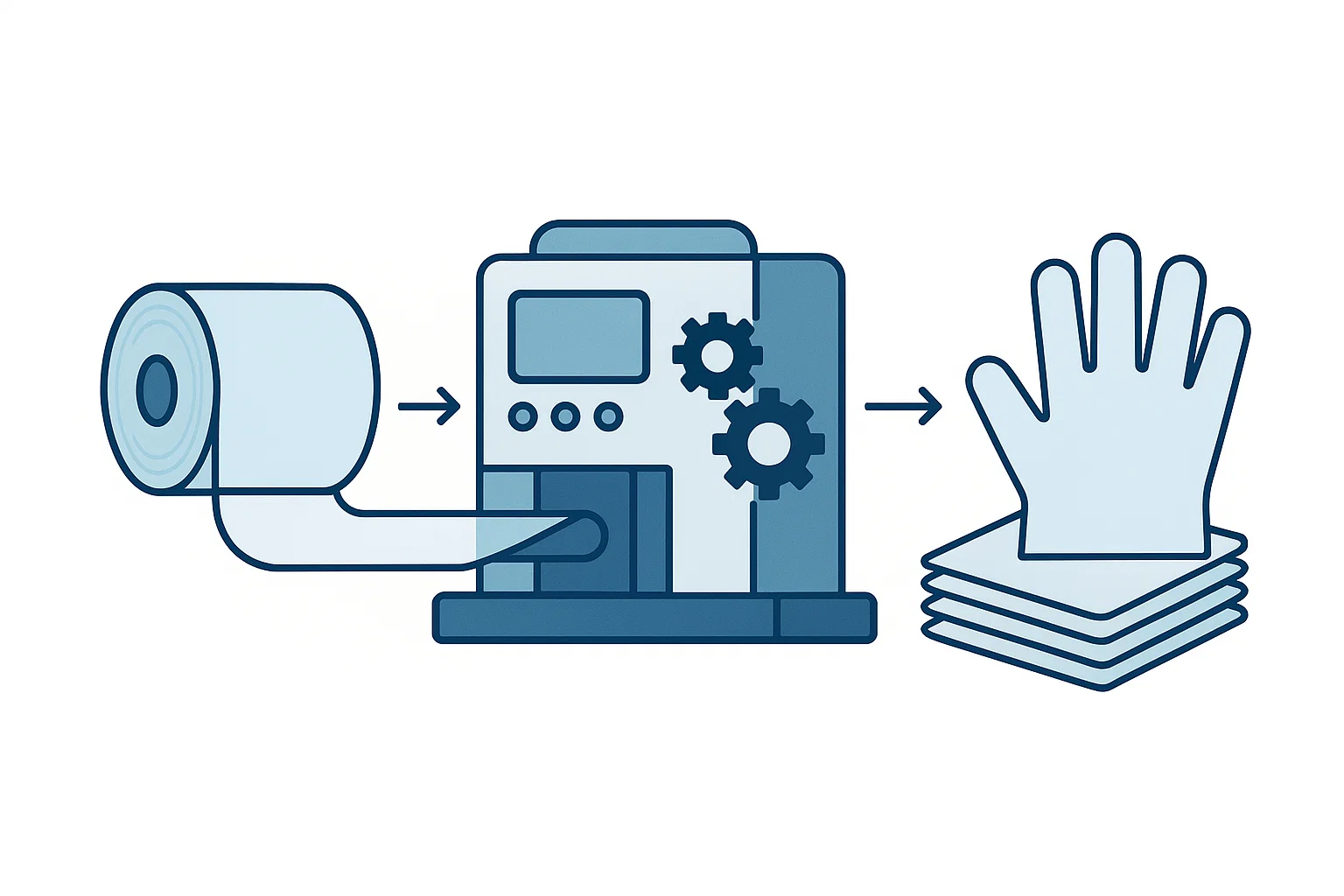ما هي ماكينة القفازات البلاستيكية التي تستخدم لمرة واحدة؟
في القطاعات التي تكون فيها النظافة والسلامة أمرًا بالغ الأهمية، مثل الرعاية الصحية وخدمات الطعام وبيئات غرف الأبحاث، تُعد القفازات التي تستخدم لمرة واحدة جزءًا لا غنى عنه في العمليات اليومية. ولكن هل توقفت يومًا للتفكير في التكنولوجيا الكامنة وراء إنتاج هذه العناصر الأساسية؟ البطل المجهول في هذه العملية هو آلة القفازات البلاستيكية التي تستخدم لمرة واحدةقطعة متطورة من المعدات المصممة هندسيًا لتحقيق الدقة والسرعة والموثوقية. بالنسبة للمشترين والمتخصصين في الصناعة، يعد فهم آليات وقدرات هذه الماكينات أمرًا بالغ الأهمية لاتخاذ قرارات استثمارية مستنيرة يمكن أن تؤثر بشكل كبير على الكفاءة التشغيلية وجودة المنتج.
من المواد الخام إلى المنتج النهائي، تُعد رحلة القفازات التي تُستخدم لمرة واحدة أعجوبة من الأتمتة الحديثة. سوف يتعمق هذا الدليل الشامل في عالم تصنيع القفازات التي تستخدم لمرة واحدة، ويستكشف العمليات المعقدة، والأنواع المختلفة من الآلات المتاحة، والميزات الرئيسية التي تحدد خط الإنتاج عالي الجودة. كما سنسلط الضوء على كيفية قيام رواد الصناعة مثل داماو تيك تتخطى حدود الابتكار لتقديم آلات تلبي المتطلبات المتطورة للسوق العالمية.
تطور صناعة القفازات: من العمل اليدوي إلى الأتمتة عالية السرعة
تحول إنتاج القفازات التي تستخدم لمرة واحدة بشكل كبير على مر العقود. كانت الأساليب المبكرة كثيفة العمالة وبطيئة، وغالبًا ما كانت تؤدي إلى عدم اتساق الجودة. أدى ظهور الأتمتة إلى إحداث ثورة في هذه الصناعة، مما مهد الطريق أمام الآلات التي يمكنها إنتاج آلاف القفازات في الساعة بأقل تدخل بشري. لم يؤد هذا التحول إلى زيادة حجم الإنتاج فحسب، بل عزز أيضًا معايير النظافة الصحية من خلال تقليل التلامس اليدوي أثناء عملية التصنيع.
إن ماكينات القفازات البلاستيكية الحديثة التي تستخدم لمرة واحدة اليوم، مثل تلك التي تم تصميمها بواسطة داماو تيكتمثل ذروة هذا التطور. من خلال دمج الروبوتات المتقدمة وأنظمة التحكم الذكية والهندسة الدقيقة، توفر هذه الماكينات كفاءة واتساقًا وتنوعًا لا مثيل له، مما يجعلها حجر الزاوية في إنتاج معدات الحماية الشخصية الحديثة.
كيف تعمل ماكينة القفازات البلاستيكية التي تستخدم لمرة واحدة؟ تفصيل خطوة بخطوة
بينما توجد ماكينات مختلفة لمختلف المواد مثل البولي إيثيلين والبولي إيثيلين تيرفثالات (TPE)، فإن العملية الأساسية لتحويل الأغشية البلاستيكية إلى قفازات نهائية تتضمن عدة مراحل رئيسية. يعمل خط الإنتاج الحديث والأوتوماتيكي بالكامل على أتمتة كل خطوة من أجل سير عمل سلس.
1. تغذية المواد وفكها
تبدأ العملية بتحميل لفة كبيرة من غشاء بلاستيكي كبير - عادةً من البولي إيثيلين (PE) أو اللدائن البلاستيكية الحرارية (TPE) - على الماكينة. يقوم نظام الفك الآلي، الذي يتم التحكم فيه غالبًا بواسطة محول التردد، بتغذية الفيلم بدقة عالية لضمان سلاسة واتساق الإمداد في خط الإنتاج.
2. تشكيل الأغشية والتسخين
بالنسبة لأنواع معينة من القفازات، خاصةً تلك المصنوعة من مواد مثل البولي إيثيلين المكلور (CPE) أو البولي إيثيلين المكلور، تقوم الماكينة أولاً بتشكيل طبقتين من الفيلم بالتوازي. يتم بعد ذلك تسخين هذه الطبقات إلى درجة الحرارة المثلى لإعدادها لمرحلة التشكيل الحاسمة. تضمن عملية التسخين هذه أن تكون المادة مرنة بما يكفي لإغلاقها وقصها بدقة.
3. قولبة القفازات وإغلاقها وتقطيعها
هذا هو جوهر عملية التصنيع حيث يأخذ القفاز شكله. يمر الفيلم البلاستيكي الساخن عبر محطة مجهزة بقالب على شكل يدوي. تستخدم الماكينة آلية ختم وقص بالحرارة للضغط على طبقات الغشاء معاً، مع لحام الحواف وقص مخطط القفاز في نفس الوقت. تُعد جودة ودقة هذا القالب أمرًا بالغ الأهمية لإنتاج قفاز ليس فقط على شكل مثالي ولكن أيضًا بدرزات قوية وموثوقة. شركات مثل داماو تيك الاستثمار بكثافة في هندسة هذه القوالب لضمان الاتساق والمتانة.
4. التجريد التلقائي للنفايات
بمجرد قطع شكل القفاز، يجب إزالة الغشاء الزائد المحيط به، والمعروف باسم النفايات. وفي الأنظمة القديمة شبه الأوتوماتيكية القديمة، كان هذا يتطلب عملاً يدويًا. ومع ذلك، تدمج ماكينة القفازات الأوتوماتيكية بالكامل التي تستخدم لمرة واحدة وحدة تجريد نفايات آلية. يفصل هذا النظام النفايات ميكانيكيًا عن القفازات الجاهزة، والتي يمكن بعد ذلك جمعها لإعادة تدويرها، مما يحسن الاستدامة ويقلل من الجهد اليدوي.
5. العد والتكديس
في المرحلة النهائية، يتم عد القفازات الجاهزة وتكديسها تلقائيًا. وتستخدم الأنظمة المتقدمة أجهزة استشعار لضمان العد الدقيق قبل تكديس القفازات بشكل مرتب وجاهز للتغليف. تقلل هذه الأتمتة من المناولة وتحافظ على النظافة وتحضير المنتج للتوزيع بكفاءة.
أنواع القفازات البلاستيكية التي تستخدم لمرة واحدة وآلاتها المتخصصة
يغطي مصطلح "القفازات البلاستيكية" مجموعة من المواد، كل منها يناسب تطبيقات مختلفة ويتطلب تكوينات محددة للماكينة.
- ماكينات القفازات المصنوعة من البولي إيثيلين (PE): قفازات البولي إيثيلين البولي إيثيلين، المصنوعة إما من البولي إيثيلين عالي الكثافة (HDPE) أو البولي إيثيلين منخفض الكثافة (LDPE)، هي أكثر أنواع القفازات البلاستيكية التي تستخدم لمرة واحدة شيوعًا وفعالية من حيث التكلفة. وهي تستخدم على نطاق واسع في صناعة الخدمات الغذائية للمهام التي تتطلب تغيير القفازات بشكل متكرر. تم تصميم ماكينات قفازات البولي إيثيلين البولي إيثيلين لإنتاج هذه القفازات خفيفة الوزن بسرعة عالية.
- ماكينات قفازات TPE (اللدائن الحرارية البلاستيكية): توفر قفازات TPE ترقية كبيرة عن قفازات البولي إيثيلين البولي إيثيلين القياسية. فهي توفر ملاءمة أكثر نعومة ومرونة مع مرونة أفضل، مقارنةً بقفازات الفينيل في كثير من الأحيان. آلات TPE، مثل تلك التي طورتها داماو تيك، مصممة للتعامل مع الخصائص الفريدة لهذه المادة، مما يضمن تشطيباً عالي الجودة وتجربة مستخدم مريحة.
- ماكينات قفازات CPE (البولي إيثيلين المكلور): تشتهر قفازات CPE بمتانتها وملمسها الناعم. وتتشابه آلات إنتاج قفازات CPE مع آلات TPE، حيث تتضمن عملية صب أو نفخ غشاء تليها عملية الختم الحراري والقطع.
الميزات الرئيسية التي يجب مراعاتها عند الاستثمار في ماكينة القفازات البلاستيكية التي تستخدم لمرة واحدة
بالنسبة للمشترين ومديري الإنتاج، يعد اختيار الماكينة المناسبة قرارًا حاسمًا يؤثر على الإنتاجية والتكلفة والقدرة التنافسية في السوق. فيما يلي الميزات الأساسية التي يجب تقييمها:
- سرعة الإنتاج والقدرة الإنتاجية: ابحث عن ماكينة يمكنها تلبية متطلباتك من حيث الحجم. يمكن أن تنتج الموديلات عالية السرعة ما بين 40 إلى أكثر من 140 قطعة في الدقيقة في كل خط، حيث تتميز العديد من الماكينات بإعدادات مزدوجة لمضاعفة الإنتاج.
- مستوى الأتمتة: A ماكينة قفازات يمكن التخلص منها أوتوماتيكية بالكامل يقلل بشكل كبير من تكاليف العمالة واحتمال حدوث خطأ بشري. تعد ميزات مثل إزالة النفايات والعد والتكديس التلقائي ضرورية لخط إنتاج فعال وصحي حقًا.
- توافق المواد وتعدد الاستخدامات: توفر الماكينة القادرة على التعامل مع مواد مختلفة مثل البولي إيثيلين البولي إيثيلين والـ CPE والـ TPE مرونة أكبر لتلبية احتياجات السوق المتنوعة والتكيف مع متطلبات العملاء المتغيرة. كما تعد القدرة على تخصيص أشكال القفازات وأحجامها ميزة كبيرة أيضًا.
- جودة البناء وموثوقية المكونات: يعتمد طول عمر الماكينة وأدائها على بنيتها وجودة مكوناتها. ابحث عن الماكينات المصنوعة من إطار فولاذي قوي لتحقيق الثبات والمزودة بإلكترونيات موثوقة من علامات تجارية مرموقة. داماو تيك، على سبيل المثال، يستخدم شاشة لمس حاسوبية صغيرة ومكونات عالية الجودة لضمان تشغيل موثوق به ومنخفض الضوضاء.
- كفاءة الطاقة وتكاليف التشغيل: في السوق التنافسية اليوم، يعد تقليل النفقات التشغيلية أمرًا أساسيًا. فالتصميم الموفر للطاقة لا يقلل من فواتير الكهرباء فحسب، بل يساهم أيضًا في عملية تصنيع أكثر استدامة، مما يوفر عائدًا أسرع على الاستثمار.
- خدمة ما بعد البيع والدعم الفني: توفر الشركة المصنعة الموثوقة الدعم الشامل، بما في ذلك التركيب والتدريب وقطع الغيار المتاحة بسهولة. هذه الشراكة ضرورية لضمان الحد الأدنى من وقت التوقف عن العمل والحفاظ على ذروة كفاءة الإنتاج.
لماذا تضع Damao Tec المعيار في تكنولوجيا ماكينات القفازات التي تستخدم لمرة واحدة
في مجال تصنيع معدات الحماية المتخصصة, داماو تيك رسّخت مكانتها كشركة رائدة موثوق بها من خلال التزامها الدؤوب بالجودة والابتكار والتركيز على العملاء. إن شركتنا الراسخة الخبرة في الصناعة في التصميم القوي والأداء المتفوق لماكيناتنا. نحن نبرهن على الخبرة من خلال دمج الأتمتة المتطورة وأنظمة التحكم الذكية التي تمكّن عملاءنا من تحقيق كفاءة إنتاج لا مثيل لها.
ملكنا الصلاحية مبني على أساس من النجاح المثبت، مع داماو تيك آلات تعمل في منشآت في جميع أنحاء العالم، وتقدم باستمرار منتجات عالية الجودة. والأهم من ذلك أننا نكسب رضا عملائنا الجدارة بالثقة من خلال عمليات تتسم بالشفافية، ودعم موثوق لما بعد البيع، وآلات مصممة لتدوم طويلاً. من خلال اختيار داماو تيكفأنت لا تشتري مجرد آلة، بل تستثمر في شراكة مكرسة لنجاحك.
مستقبل إنتاج القفازات: الاستدامة والتكنولوجيا الذكية
يتشكل مستقبل تصنيع القفازات التي تستخدم لمرة واحدة من خلال اتجاهين رئيسيين: الاستدامة والتكنولوجيا الذكية. يبحث المصنعون بشكل متزايد عن آلات تقلل من النفايات ويمكنها معالجة المواد القابلة للتحلل أو القابلة لإعادة التدوير. في الوقت نفسه، سيؤدي دمج إنترنت الأشياء (إنترنت الأشياء) والتحليلات القائمة على الذكاء الاصطناعي إلى تمكين خطوط الإنتاج "الذكية" التي يمكنها تشخيص المشكلات ذاتيًا، وتحسين الأداء في الوقت الفعلي، وتوفير بيانات قيمة لتخطيط الإنتاج. داماو تيك تعمل بنشاط في مجال البحث والتطوير لدمج هذه الميزات المستقبلية في الجيل القادم من ماكينات القفازات البلاستيكية التي تستخدم لمرة واحدة.
الخاتمة
إن آلة القفازات البلاستيكية التي تستخدم لمرة واحدة من الأصول المهمة لأي مصنع في صناعات معدات الوقاية الشخصية أو الخدمات الغذائية أو الإمدادات الطبية. فهي أكثر من مجرد قطعة من المعدات، فهي محرك الإنتاج، وتؤثر بشكل مباشر على الإنتاج والجودة والربحية. من خلال فهم عملية التصنيع المعقدة، وأنواع الماكينات المختلفة، والميزات الرئيسية التي يجب البحث عنها، يمكن للمشترين والمتخصصين في الصناعة القيام باستثمارات استراتيجية تحقق فوائد طويلة الأجل.
مع استمرار تقدم الأتمتة والتكنولوجيا، فإن الشراكة مع شركة مصنعة ذات خبرة وابتكار مثل داماو تيك يضمن لك الحصول على الأدوات والدعم اللازمين للازدهار في مشهد تنافسي، وتقديم المنتجات الأساسية التي تحمي الأشخاص والعمليات في جميع أنحاء العالم.
الأسئلة الشائعة (FAQ)
1. ما هو الفرق الرئيسي بين ماكينة القفازات البلاستيكية شبه الأوتوماتيكية وماكينة القفازات البلاستيكية التي تستخدم لمرة واحدة أوتوماتيكية بالكامل؟
تتطلب الماكينة شبه الأوتوماتيكية عادةً تدخلاً يدويًا في بعض خطوات المعالجة، وأكثرها شيوعًا إزالة النفايات بعد قطع القفازات. وعلى النقيض من ذلك، تدمج الماكينة الأوتوماتيكية بالكامل أنظمة آلية لكل مرحلة، بما في ذلك تغذية المواد، والختم، والقطع، وإزالة النفايات، والعد، مما يقلل بشكل كبير من تكاليف العمالة ويزيد من الكفاءة.
2. ما هي المواد الخام التي يمكن لماكينة القفازات البلاستيكية متعددة الاستخدامات التي تستخدم لمرة واحدة معالجتها؟
صُممت الماكينات عالية الجودة ومتعددة الاستخدامات لتكون متوافقة مع مجموعة من أغشية اللدائن الحرارية. المواد الأكثر شيوعًا هي البولي إيثيلين عالي الكثافة (HDPE) والبولي إيثيلين منخفض الكثافة (LDPE). العديد من النماذج المتقدمة، بما في ذلك النماذج من داماو تيككما يمكنها أيضًا معالجة أغشية البولي إيثيلين المكلور (CPE) والبولي إيثيلين المكلور (TPE) بكفاءة، مما يسمح للمصنعين بإنتاج أنواع مختلفة من القفازات لتلبية متطلبات السوق المختلفة.
3. ما مقدار الصيانة التي تتطلبها ماكينة القفازات البلاستيكية التي تستخدم لمرة واحدة؟
تم تصميم الماكينات الحديثة من أجل المتانة وسهولة الصيانة. تتضمن الصيانة الدورية عادةً تنظيف قوالب الختم والقطع، والتحقق من شد نظام التغذية، والتأكد من أن المكونات الإلكترونية وأنظمة التحكم تعمل بشكل صحيح. تعمل الماكينات ذات المكونات عالية الجودة وأنظمة التشحيم المريحة على تبسيط هذه العملية، مما يضمن عمرًا تشغيليًا أطول وأداءً ثابتًا.
4. هل يمكن تخصيص حجم القفاز وشكله على الماكينة؟
نعم، إحدى السمات الرئيسية لماكينات القفازات الحديثة التي تستخدم لمرة واحدة هي القدرة على تخصيص المنتج. يتم تحديد شكل القفاز وحجمه من خلال القالب المستخدم في محطة الختم والقطع. وغالبًا ما تكون هذه القوالب قابلة للتبديل، مما يسمح للمصنعين بإنتاج مجموعة متنوعة من الأحجام (على سبيل المثال، صغيرة، ومتوسطة، وكبيرة) وحتى الأشكال المخصصة لتلبية تطبيقات محددة أو متطلبات العملاء.


